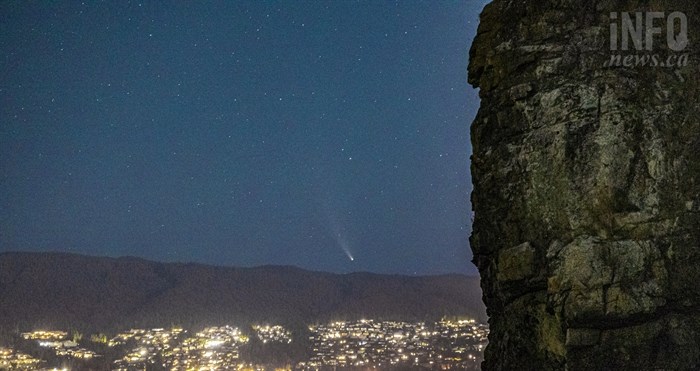
A photo of C/2020 F3, better known as Neowise, which was visible from the Northern Hemisphere in July 2020.
(DAN WALTON / iNFOnews.ca)
December 09, 2021 - 6:30 AM
A comet that spent eons travelling towards earth for this week’s flyby will continue getting brighter until Saturday for skywatchers in Kamloops and the Okanagan.
Leonard, the name given to C/2021 A1, is offering a rare opportunity for earthlings to witness a comet with the naked eye.
Dr. Chris Gainor, past president of the Royal Astronomical Society of Canada, told iNFOnews.ca he remembers two “fabulous” comets making visible flybys in the mid 1990s.
“Then basically there was nothing like that until Comet Neowise came by last year,” he said.
“It’s not everyday you have a good comet come along.”
READ MORE: iN VIDEO: Watch this spectacular time-lapse of Neowise comet over Vernon
Dr. Gainor said Leonard likely came from the Oort cloud, the outer limit of the sun’s gravity which forms a massive spherical shape extending light-years in distance.
It was probably directed towards earth “many thousands of years ago, quite a while ago ... Something, perhaps even a star out there somewhere, disturbed its orbit, so it started to fall in,” he said.
The comet will reach the orbit of Venus before it starts to curve away from the sun. It will then begin to make its way out of the solar system.
“This one’s not coming back, that’s what they calculate,” said Dr. Gainor.
“It’s because of its trajectory – a lot of comets will return, like Neowise is going to come back – even though none of us are going to be around to see it.”
But this will be Leonard’s one and only pass by the earth.
As the comet faces higher temperatures on its journey towards the sun, it constantly sheds some of its frozen contents and forms a tail. Once it gets farther away from the sun it will lose the tail and continue on its path.
“The tail is an effect of the solar wind,” Dr. Gainor said. “At the core of a comet you have kind of a rocky, icy piece of matter. It’s like a dirty ice cube in some ways – usually a lot of ice, but also dust and dirt and rocks mixed in.”
Comets passing by earth aren't necessarily rare but most are too small to be visible to the naked eye, he said.
READ MORE: How to make your night sky photography stand out
He doesn’t expect Leonard to be as bright as Neowise so he recommends using binoculars to spot it easier. From Kamloops and the Okanagan it will appear in the skies towards the east or northeast.
For anyone living in a valley, it makes sense to view the eastern sky from the western hills. And the comet will appear brighter in areas with less light pollution.
Between now and Dec. 11, Dr. Gainor said Leonard will only be visible early in the morning around 5 or 6 a.m.
“And only if it’s clear of course … one big question is, what are the weather gods going to do?”
After Dec. 11, Leonard will become visible for sky gazers in the Southern Hemisphere until January. Then it will vanish from earth’s sight forever.
To contact a reporter for this story, email Dan Walton or call 250-488-3065 or email the editor. You can also submit photos, videos or news tips to the newsroom and be entered to win a monthly prize draw.
We welcome your comments and opinions on our stories but play nice. We won't censor or delete comments unless they contain off-topic statements or links, unnecessary vulgarity, false facts, spam or obviously fake profiles. If you have any concerns about what you see in comments, email the editor in the link above.
News from © iNFOnews, 2021